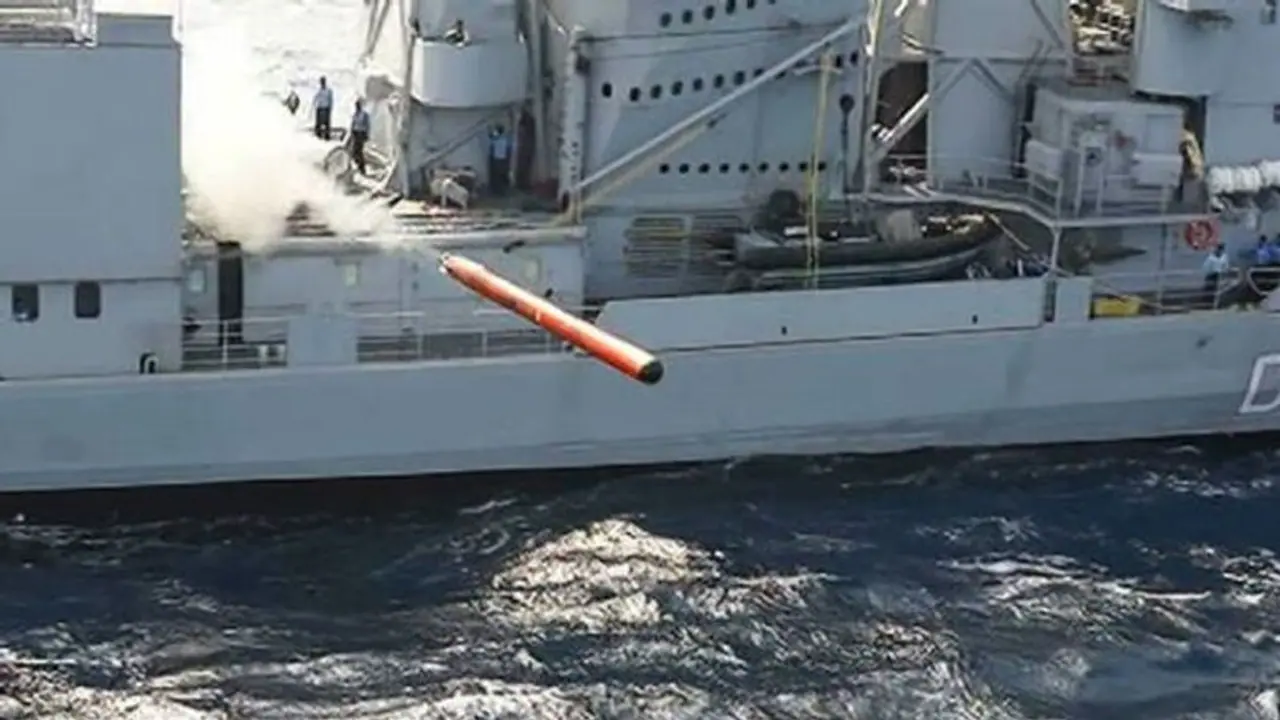Varunastra, the heavyweight torpedo was inducted in 2016 and can be launched from any Anti-Submarine Warfare {ASW} vessel, even when facing intense countermeasures. Defence Expert Girish Linganna explains why this indigenously-developed missile is a gamechanger.
Earlier today, a milestone was achieved by the Indian Navy and the Naval Science and Technological Laboratory (NSTL) of the Defence Research and Development Organisation (DRDO) when the domestically produced heavy-weight torpedo Varunastra (named after a mythological weapon created by the Hindu god of the oceans, Varuna) effectively struck a submerged target off of the western coast.

The successful engagement of the underwater target by the India-manufactured heavy-weight torpedo marks an important step in the Indian Navy's and DRDO's mission to precisely deploy munitions at the intended target in the underwater environment.
The Indian Navy released an eight-second video showing the Varunastra torpedo striking a submerged pontoon{Boat Bridge or hanging Bridge} in the sea. Upon hitting the target, the pontoon is destroyed and the explosion causes the shockwaves to ripple through the water, creating a surge.
The Navy spokesperson emphasized the Indian Navy's dedication to achieving Future Proof Combat Readiness through Aatmanirbharta, which was bolstered by the successful engagement with Varunastra. This heavy-weight torpedo was inducted in 2016 and can be launched from any Anti-Submarine Warfare {ASW} vessel, even when facing intense countermeasures.
The Varunastra is expected to replace the existing American Mark 46 torpedoes in the Indian Navy's inventory.
The Varunastra is a wire-guided, active-passive acoustic homing torpedo with a range of up to 40 kilometres. It can operate at depths of up to 600 meters and can carry a 250-kilogram warhead. The torpedo is designed to be launched from surface ships, submarines, and aircraft.
What is a torpedo?
A torpedo is a self-propelled underwater missile that can be launched from a submarine, ship, or aircraft to destroy enemy ships or submarines. It is typically a long, thin cylinder with a pointed nose and a tail fin. Torpedoes can be powered by electric motors or compressed air, and they can be equipped with a variety of warheads, including high explosives, nuclear weapons, or mines.
Torpedoes have been used in warfare since the early 19th century, and they played a major role in both World Wars. Today, they are still an important weapon in the arsenals of many navies around the world.
What is a heavyweight torpedo?
A heavyweight torpedo is typically used to attack surface ships and submarines, while lightweight torpedoes are typically used to attack smaller targets, such as small boats and mines.
Heavyweight torpedos are typically powered by electric motors or gas turbines, and they can travel at speeds of up to 50 knots. They have a range of several miles, and they can carry a variety of warheads, including high-explosive, nuclear, and anti-submarine warheads.
Some examples of heavyweight torpedoes include the Mark 48 torpedo, the Varunastra torpedo, and the F-21 torpedo.
Advantages of heavyweight torpedo
* The heavyweight torpedo has a longer range than the lightweight variant.
* The heavyweight torpedo can carry a bigger warhead.
* The heavyweight torpedo is more powerful and can damage larger targets.
Disadvantages of heavyweight torpedo
* It is more expensive than a lightweight torpedo.
* It is more difficult to maintain and operate.
* Since it is heavier, it is much more difficult to transport and deploy.
Varunastra's Specifications
The Varunastra, an indigenous heavyweight torpedo, has been designed by the DRDO's Naval Science and Technological Laboratory in Visakhapatnam. This electrically-powered anti-submarine device has the ability to target submarines in both deep and shallow waters.
* Varunastra is measured at 7.780 metres in length.
* The size of its diameter is 533.4 mm.
* Varunastra's maximum speed is 74 kilometres per hour.
* It weighs 1605 kg (exercise version), 1850 ± 10 kg (Combat version)
* Varunastra has a long range and can move in many different ways.
* Varunastra has acoustic homing with a wide look angle capable of tracking silent targets.
* It has acoustic countermeasures (ACCM) and more than one method for tracking signals. ACCM makes a noise to trick the enemy ships and torpedos' sonar guidance systems.
* It has navigational devices that last for a long time and don't drift much.
